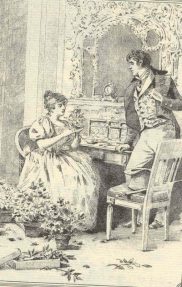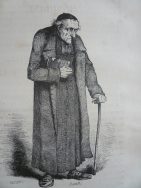
Honorine
THE HUMAN COMEDY – Honoré de Balzac Fourth volume of works of Honoré de Balzac edited by widow André Houssiaux, publisher, Hebert and Co, successors, 7 rue Perronet – Paris (1877)

Honorine and Octave
HONORINE
A short story written in three days by Honoré de Balzac at the end of December 1842,
Analysis of the work Honorine is one of Balzac’s least-known short stories, and also one of his most embarrassing. For it admits of two very different interpretations, between which it is difficult to decide. What’s more, Balzac wrote two very different endings for this story, one belonging to the first draft of his manuscript, the second substituted for it in the proofs, at the time of the “bon à tirer”. It was written in three days,” said Balzac to Madame Hanska at the end of December 1842. The manuscript was subsequently expanded and reworked, and the final draft was not ready until February 1843. Is this the mark of some kind of hesitation about the meaning to be given to the news? It’s a case of “casuistique amoureuse”, says one of Balzac’s best editors, M. Pierre Citron. In this regard, he evokes The Princess of Cleves. This definition seems to be borne out by the layout of the novel. There are only three characters; there’s no action, but scruples, debates, everything is in the secret of souls. But at the same time, Pierre Citron gives a physiological explanation of events that is also the one presented by Félicien Marceau. Is casuistry in love a euphemism for a banal situation in which the husband’s inexperience is most often the main cause? It’s a story told by one of the actors in a beautiful Genoese palace: a frequent setting in Balzac’s work, which helps to set a certain mood, choose a certain tone of intimacy and good company, and bring out the conclusion. This is where the two endings come in. In the first, all ends well: she loves her good husband, who has given her this rare proof of fidelity, and they have many children. In the second, the final denouement: she returns to the husband she admires, to whom she devotes a deep affection, and she dies of grief at this surrender. Definitely not a vaudeville. But it seems clear enough that Balzac has blended in this story two ideas he has about women, both accurate, both profound, but whose proximity creates a certain ambiguity. The first is one of Balzac’s key ideas. It was expressed at the very beginning of his career in his Physiology of marriage; is found in several of his novels; it is illustrated above all in the Memoirs of two young brides A man should not ask of his wife what he asks of his mistresses: the purpose of marriage is the family and children, the condition of the woman’s dignity and happiness in the household. Balzac repeats this dogma most clearly in Honorine: “Marriage excludes passion, the family cannot have the storms of love as its basis.” But Balzac, in his “women’s studies”, almost as often expressed another idea that he considered essential. When a woman has given in to love, when she has committed a fault, her honor as a woman forbids her to return; she swallows herself whole if this fault she has committed against the law and in defiance of opinion is not inspired by a sublime and unique sentiment. If she accepts another love, she condemns herself in her own eyes; another love, other loves, make her a woman passed from hand to hand; a return to her husband is a kind of conjugal prostitution. The choice of the second ending makes it quite clear that it was this demanding conception of feminine modesty and honor that prevailed. Honorine, trapped by her husband’s promise to live with her as a brother with his sister, agrees to return. But her admiration for her husband’s character, his fidelity and his devotion eventually made her give in. And she’s dying because she’s stained the ermine dress she’s made for herself by her seclusion. And her last words, in the letter she wrote before her death, reveal a drama she hid from everyone: “Intimacy without love is a situation where my soul is dishonored at all hours.” This word, which is like the secret light that illuminates the whole story and gives it its beauty, can hardly be explained by a simple misunderstanding of meanings. Of course, this misunderstanding existed. Balzac makes no secret of it. But she’s only the cause of the drama. The drama itself is Honorine’s return. Octave de Bauvan’s love triumphed. But he realizes too late the price he has paid for this victory. He killed his wife, he knows it. And he died a few months later from the knowledge.
The story The story is that of the Comte de Bauvan, grand seigneur and minister of state, married young to a childhood sweetheart he adores. Abandoned by his wife for another man, desperate but still in love, he searches for her. The police give him his address. He then learns that, abandoned by the man she ran away with, she’s a poor woman who makes artificial flowers to survive. The great statesman uses a thousand tricks to soften her misery: he has his accomplices buy the product of his labor, assumes a landlord who lodges her free of charge in a delightful mansion; thanks to him, she finds ravishing toiletries and elegant furniture, believing them to be sales. For Honorine, it’s an enchanted retreat where the miracle of abundance is renewed every day. These prodigalities were assured for seven years. No one suspects the secret of the Count, who comes every evening to admire Honorine, who, despite her pleas, will not return to her husband. As far as the world is concerned, the Countess is supposed to have embarked on a shipwreck. She passes for dead. Balzac, in his “Etudes de femmes”, expresses the following theory: The mores of the time banish a woman who has yielded to the love of a man other than her husband. When a woman has given in to love, her honor as a woman forbids her to return. More often than not, she exiles herself, retiring to the provinces. The woman who accepts another love, other loves, acquires the reputation of the woman who is passed from hand to hand. Returning to your husband is considered marital prostitution. The novel’s dramatic denouement explains why, in Balzac’s view, feminine modesty and honor prevailed. Trapped by her husband’s promise to live with her as a brother with his sister, Honorine’s admiration for her husband’s personality, love, fidelity and devotion to her will make her agree to return to live with him. Shame, the emptiness of her life, the lack of love for this model husband, the memory of loved ones (her lover, the dead son she had with him), will finally kill this woman. She’ll do anything to live up to Octave’s love, so that he’ll believe he’s adored by her. Honorine even gave him a son shortly before his death. Paris, January 1843
Source analysis: Preface and story compiled from the full text of the Comédie Humaine published by France Loisirs 1985 under the auspices of the Société des Amis d’Honoré de Balzac.
The characters Bauvan: Noble family represented by the Count of Bauvan and his wife. A widow, she is perhaps best identified with “Charette’s mare”, who appears in Les Chouans as Mme du Gua-Saint-Cyr. Count Octave de Bauvan: Son of the Count and Countess de Bauvan. Minister of State, famous ministerial orator, husband of Honorine. Honorine: (1794-1831) Octave’s father’s child. Honorine is a rich and beautiful young woman. She was 16 when Octave returned home from college. A love marriage was agreed between the two children. Octave’s overprotection of his young wife and the routine of a household devoid of surprises and fantasies are the foretold chronicle of Honorine’s flight with the man who stirs her heart and whose child she will lose.

Abbé Loraux
Some information on the genealogy of the characters comes from Félicien Marceau’s excellent book ” Balzac et son monde – Gallimard “.
No Comments